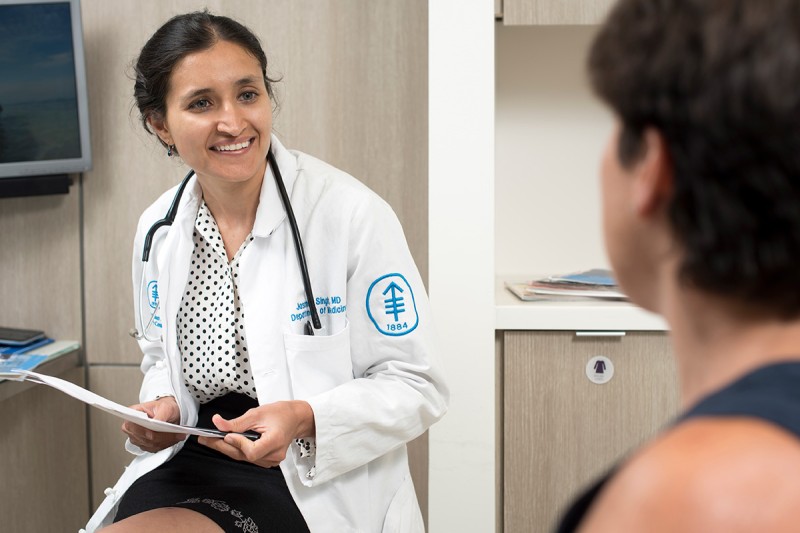
Medical oncologist Jasmeet Singh is an expert in treating people with breast cancer.
It can be hard to stay on top of current breast cancer screening guidelines because the advice is sometimes confusing or conflicting. Test your breast IQ with our short quiz, and post your results in the comments!
1. At MSK, we stand by the guidelines echoed by many medical associations. Per those recommendations, a woman with an average risk of breast cancer and no family history of the disease should begin annual mammograms at age:
A) 40
B) 45
C) 50
D) 55
Answer
Answer: A, 40
While the US Preventive Services Task Force recommends screening every two years starting at age 50, many medical professionals disagree. “Here at MSK, we’re sticking to keeping it simple,” Dr. Morris says. “The Society of Breast Imaging, the American College of Radiology, and the National Comprehensive Cancer Network all recommend annual screenings starting at age 40 for people at average risk. We believe that saving the most lives is the most important thing we can do as physicians, and nearly everyone agrees that the most lives are saved if you start screening at 40.”
2. When a woman has a mother or sister who was diagnosed with breast cancer before the age of 50, MSK recommends she undergo annual mammograms beginning at what age?
A) one year before the age at which her relative was diagnosed
B) five years before the age at which her relative was diagnosed
C) ten years before the age at which her relative was diagnosed
D) 15 years before the age at which her relative was diagnosed
Answer
Answer: C, ten years
“If you are at an increased risk for breast cancer, everything changes,” Dr. Morris says. “You should start getting a mammogram every year, ten years before their diagnosis. So if they were 40, you should start at 30.” The one caveat: Women should not get mammograms before the age of 25 so that they aren’t overexposed to radiation. Women at an increased risk for breast cancer are eligible to participate in MSK’s breast surveillance program, RISE (Risk Assessment, Imaging, Surveillance and Education).
3. When is the best time of month to do a breast self-exam?
A) At the start of your period
B) Mid-cycle
C) Right before your period is about to start
D) It’s not advisable to do breast self-exams
Answer
Answer: B, Mid-cycle
Breast self-exams are a good way to get to know your breasts, Dr. Morris says, so that you can recognize any changes that develop. Mid-cycle, breasts are the least swollen and tender, making for an easier exam.
4. Which screening tool can pick up the most breast cancers?
A) Mammogram
B) Mammogram with contrast
C) MRI with contrast
D) Ultrasound
Answer
Answer: C, MRI with contrast
Over the years, mammography has certainly improved: tests have gone from analog to digital, and from two-dimensional to three-dimensional. In fact, 3-D mammograms — which are better at delineating between cancers and non-cancers — are now standard at MSK, Dr. Morris says. But mammograms aren’t perfect: They can sometimes miss cancers that are very small, and they can’t see clearly through tissue in women with dense breasts. An MRI with contrast gives a much closer look, down to the blood vessels that are supplying a tumor. While Dr. Morris thinks this type of screening could become “the game-changer we need,” MRI with contrast is relatively new. In the meantime, a mammogram with contrast is more in-depth than a standard mammogram, and is less expensive. Ask your doctor if it’s right for you.
5. True or False: You can tell if you have dense breasts by their look and feel.
Answer
Answer: False
It’s important to know if you have breasts that have a low amount of fatty tissue — also known as dense breasts — because women with dense breasts have a higher risk of breast cancer. The only way a doctor can tell if you have dense breasts is through an imaging study like a mammogram or an MRI. “Density has no association with how they feel and what they look like,” Dr. Morris says. “You can have very lumpy breasts that can be totally fatty on the mammogram, or very smooth breasts that are actually very dense.”
6. True or false: Most of the time, an abnormality on a mammogram is not cancer.
Answer
Answer: True
Mammograms can pick up all sorts of things that aren’t breast cancer, like calcifications and benign cysts. But these non-cancerous spots are hard to decipher on a mammogram, so sometimes a doctor will ask the patient to do a repeat test just to be safe. That’s enough to stress anyone out, but it doesn’t need to. Upon a second examination, only 20% of abnormalities need to be even further analyzed through a biopsy, Dr. Morris says. And even then, the vast majority of those biopsied samples turn out to be nothing. “Very few callbacks turn out to be cancer,” she adds.
7. True or false: The size of a breast lump determines how dangerous it is.
Answer
Answer: False
“It’s more about tumor biology,” Dr. Morris says. “You could have a tiny little cancer that’s very aggressive, or a palpable, large tumor that may have low aggressiveness.”
8. True or false: One obvious sign of breast cancer is a painful lump.
Answer
Answer: False
Breast cancer “usually doesn’t hurt,” says Dr. Morris. “When people come in with pain in their breasts, it’s usually something benign,” she says.

